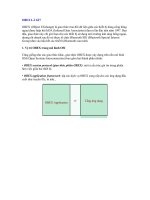Tài liệu PGP - Step by Step pptx
Bạn đang xem bản rút gọn của tài liệu. Xem và tải ngay bản đầy đủ của tài liệu tại đây (763.07 KB, 37 trang )
1
Introduction to PGP – SANS GIAC LevelOne -
© 2000, 2001
1
PGP - Step by Step
Hello, my name is Stephen Northcutt, and in our next hour together we will be discussing the
application of cryptography, as opposed to the theory of cryptography.
I can’t stress the objective of this course strongly enough. I hope you will consider getting Pretty
Good Privacy (PGP) and trading keys with people that we may need to communicate with in a
secure manner. PGP is easy, widespread, and free to low cost. There is no excuse for not having
this tool in your toolbox.
Let me illustrate with a story. SANS’ web server is on a BSDI box. For now, GCC is really a
challenge on BSDI. That is OK, since it is the fastest OS in the galaxy and you don’t *really* want
too many applications compiled on a production web server. But Gnu PGP likes to compile with
GCC. We always wanted PGP, but what to do?
2
Introduction to PGP – SANS GIAC LevelOne -
© 2000, 2001
2
What You Will Get From This
Course
– Secure your email
– Digitally sign your email
– Secure a file at rest on the disk
– Obtain and use a certificate
So, SANS gets a call at the end of March from the FBI’s National Infrastructure Protection Center
(NIPC) asking for help to get the word out to intervene on the 911 (or Chode) virus since at that
moment, none of the anti-virus companies had code to stop it. We had to send the advisory out on
April 1st. For my international friends, April 1st is called April Fool’s Day and is a traditional day
for jokes. Worse, to get the report to as many people as possible, we said “send this to as many
people as possible” - a hallmark of virus hoax letters. If we had PGP, we could have easily signed
the message. We have a backup trick for now! As it was, I spent the next three days answering,
“why didn’t you sign your advisory messages?”.
In a sense, we can consider PGP a form of Public Key Infrastructure (PKI). Once this structure is in
place, it is fairly easy to maintain and manage from an administrator’s point of view. Depending on
how much security you wish to impart to your users, you could even automate the tasks. Automation
will be covered in this course, as well as applicable security models for using automation.
If you choose, you can build an E-Commerce site or a secured Extranet with the infrastructure you
are learning to build in this course. Of course, you will have to scale the systems up quite a bit in
order to accommodate the large number of users you hopefully will attract to your site.
3
Introduction to PGP – SANS GIAC LevelOne -
© 2000, 2001
3
You Will Learn in This
Segment:
• How to install PGP on an email system
• How to use PGP to encrypt data
• How to sign data and what that means
• Key management
• Key servers for PGP (public key), and how to
use them
• Pros and cons to the PGP style of key
management
This segment will step you through how to install PGP onto your email client. The purpose of starting
with this step is to familiarize you with the basic structure of PKI, and help you understand how PKI
works with other systems.
PGP is a good starting place as it is very simple to install on your system, and will give you a very
good look into PKI and how it works. There are many steps that you can perform manually (like
exporting and importing information) which will give you a great feel for what larger PKI systems are
doing.
Please note that PGP is freeware, and that you would not want to use it for your business. You can
use it for personal use, but should not try and use it to generate money for your company without
purchasing licenses for PGP from Network Associates, Inc. (NAI). If you choose to use PGP for your
business, the purchased copy works very much the same way, but has many added features. I found it
rather challenging to buy PGP, though. I went to the NAI web site and clicked Buy and Shopping
Cart and it said “A salesperson will call” instead of letting me give them a credit card number and
download the software. Now, once a week, NAI calls and tries to sell me anti-virus software - go
figure. Not to worry, NAI may not be in business much longer the way they are going, but PGP
always finds a way to survive. To be legal, I just went to Best Buy and bought a few boxes of
McAfee Office 2000 and then downloaded the latest freeware version to use.
The commercial version of PGP can be obtained from Network Associates at the following sites:
Retail/personal version: McAfee.com Store at
Business/corporate version: PGP web site at
Links to download the freeware version of PGP appear on slide 6
4
Introduction to PGP – SANS GIAC LevelOne -
© 2000, 2001
4
Purpose of PKI
•Two main uses
– Secure data (hide data)
•VPN
– Authentication
• E-commerce
• Web authentication
PGP encrypts email and can be used to encrypt files on your hard drive. The version of PGP you are
going to be downloading also has a Virtual Private Network (VPN) client (PGPNet) included.
Strictly speaking, calling PGP a PKI component could lead to criticism from purists, and we will see
why as we examine certificates. However, the commercial version of PGP supports both X.509 PKI
and VPN IPSec functionalities. Since one of the big hurdles is to get people comfortable with and
using encryption, I think this is fully reasonable.
Technically, VPN is both authentication and securing data. You have to authenticate with your VPN
server (as the client), and once you have established your identity with the server, your VPN system
then encrypts the data, hiding it from view. The main purpose of VPN, however, is to enable you to
use a public network for private network traffic. The enhanced PGPNet is a VPN! Freeware PGP
gives you authentication and data security for email - you can use a public mail network to send
private mail.
5
Introduction to PGP – SANS GIAC LevelOne -
© 2000, 2001
5
Secure Email -
a Simple Example
• PGP – A pioneer, still going strong.
– PGP started out in 1991 as a way to bring privacy
to a very new, very public communication
medium: email.
– PGP at version 2.6.2 became a de-facto standard
for email encryption.
– PGP became part of Network Associates, and
moved to version 6.0.X.
– PGP is now at version 6.5.8 with new features.
Phillip Zimmermann was the person that brought PGP to the world. He wanted to make PGP a free
software tool to keep email private, releasing the software in 1991. The United States government
viewed this as a violation of the export restrictions for cryptographic software, and made his life
pretty tough until the case was dropped in 1996. Though there is now a commercial version of PGP,
Phil Zimmermann continues to make it possible to acquire free versions.
Because it was free and very hard (at the time) to break, it became very effective in hiding data from
anyone. There have been many versions of PGP and many restrictions placed on it, as a result. The
Massachusetts Institute of Technology (MIT) distributes the new PGP and PGPNet version 6.5.8.
Network Associates owns the commercial version of PGP, and in concert with MIT, distributes the
free version as well.
6
Introduction to PGP – SANS GIAC LevelOne -
© 2000, 2001
6
How to Install and Use PGP
• What you will need
– An email system to exchange email
–To get PGP and get more information
on PGP 6.5.x:
• />– To get the latest International version
of PGP 6.5.xi
• />PGP 6.5.x will work with Outlook 97, 98 or 2000 and Outlook Express 4.x/5.x. Also, PGP 6.5.x will
support Qualcomm Eudora; Lotus Notes; Novell GroupWise; and the Claris emailer for Macintosh if
you are not using any of the Microsoft products. On the UNIX side, support is available for exmh and
Mailcrypt, among others.
You can run Windows 2000 to use PGP 6.5.x or PGP 6.5.xi. Windows 2000 is a VPN beast, by the
way, and may well become a major player in the secured communications realm. You can now run
the PGP 6.5.x products on Windows 95 and Windows 95a. This used to be a big limitation. The
newest version of PGP also supports the Intel III processor math enhancements as well.
I will be covering the United States version of PGP in this presentation, but you can download the
International version of PGP and still follow along if you are unable to obtain the domestic US and
Canada version. Keep in mind the key sizes will be different on the International version.
7
Introduction to PGP – SANS GIAC LevelOne -
© 2000, 2001
7
Installing PGP on Your System
• System requirements for PGP 6.5.x.
– You will need.
• A machine running Windows 95, 98 or ME, or a
Windows NT system with at least Service Pack
3 or higher.
• You will of course need TCP/IP and TCP/IP
connectivity for your email to work!
• This free version of PGP does not support
certificates with PGPNet.
The free version of PGP does not support certificates. The certificate limitation is really unfortunate,
since it means that mailers using PGP can’t inter-operate with those using Secure MIME (S/MIME) to
protect electronic mail. The most popular certificate formats are PGP and X.509. Although they
contain essentially the same information, that information is formatted differently. This is a strong
motivator to convince users to move to the commercial version of PGP.
The certificate is how a user of public key cryptography publishes their public key. A certificate
identifier is used to “point” to the individual that holds the corresponding secret key.
With PGP the identifier is a name and email pair. For instance:
John Green <>.
With X.509 the identifier is called the distinguished name. You may have received email in a similar
format:
O=SANS Institute,OU=GIAC,CN=John Green
In this example, O stands for Organization, OU for Organizational Unit and CN for common name.
8
Introduction to PGP – SANS GIAC LevelOne -
© 2000, 2001
8
Establish a Key (Generate a
Public / Private Key Pair)
• In PGP, you will get a screen like this wizard
to generate a key pair:
The first part of the wizard establishes the information (or label) that will be associated with your key.
You will want to give your correct name, if you are not making a test key, so that your key will be
easy to identify. You will also want to use your correct email address as it will be bound to your key.
When you change email addresses, you will have to get a new key, as the trust level of your key will
look suspicious coming from a different email address then the one that is bound to your key.
You can always get a permanent email address, which entails obtaining a domain, then either an email
forwarding service, or your own equipment. This way you would never have to change your key
again.
Remember though, you had better not forget your password or passphrase or lose that key - anything
that you have encrypted (files or email) and have not decrypted will be forever lost if you either lose
the key, or forget the password.
9
Introduction to PGP – SANS GIAC LevelOne -
© 2000, 2001
9
Generating Your Key
• You will be prompted to choose a key type
and size:
You have two choices of key types, Diffie-Hellman/DSS or RSA. Diffe-Hellman/DSS is an older
public key cryptography method with the “DSS” added later. The DSS stands for Digital Signature
Standard, and was added to Diffie-Hellman to prevent man-in-the-middle attacks.
Briefly, what this means, is that someone can intercept your public key and generate their own public
key and impersonate you. A message is passed, you intercept it, decrypt it, read and alter (if
necessary) the message, and re-encrypt it with your imposter key. The person that the message was
originally intended for, gets the message with the assumption that the person they sent it to, was the
originator of the message they just got. The Digital Signature was added to include Station to Station
(STS) information into the Diffie-Hellman standard, preventing man-in-the-middle attacks.
RSA is already a Digital Signature-based public key system. There are no advantages between using
one over the other; they are essentially equal in power.
Now, we have a very important issue about key length or key size. The key length that you choose is
really based on how long you want to keep your information secret and how long the data needs to be
hidden.
10
Introduction to PGP – SANS GIAC LevelOne -
© 2000, 2001
10
Generating Your Key
• Next, how long the key is good for and a pass
phrase to protect the key.
• Notice you will have an indicator telling you how strong
your pass phrase is:
512-bit key lengths are considered only marginally safe, and you do not have the option to choose that key
length in modern PGP. Your lowest strength is 1024. Recently, it was thought that a 1024-bit key could be
safe for a decade in either a Diffie-Hellman/DSS or RSA scheme. But, with Internet Worms and clustering
of high performance computers to crack these codes, 10 years of safety is not realistic. The current default is
2048-bit and this is what I use.
To break an RSA system, integer factorization is used, while discrete logarithms using prime numbers in the
factor is the attack used on the Diffie-Hellman/DSS system.
Elliptic curve cryptography is slowly being brought in as the key sizes for Diffie-Hellman/DSS and RSA
keep getting bigger and bigger. Elliptic curve cryptography can use a smaller key and protect as well as a
larger key in the previous systems. Until Elliptic curve cryptography can be trusted to be safe (unlikely since
a 109-bit key has been cracked), the RSA and Diffie-Hellman/DSS systems will remain popular.
Next, you need to set an expiration date and passphrase for your key. For the purposes of this test, DO NOT
set an expiration date on your key. The passphrase needs to be just that: a phrase. Use a sentence that you
can remember. Use spaces and punctuation as appropriate. Use some non-alphanumeric data in addition to
proper punctuation. This is what protects your key over time!
11
Introduction to PGP – SANS GIAC LevelOne -
© 2000, 2001
11
Generating Your Key
• You will then be told that the software is
generating a prime number to build the key.
Next, you are prompted to send your key to a
key server. We will cover this more later, but
for now leave that option unchecked.
The larger your passphrase, the harder it is to guess and break when attacks against your public key
are undertaken. It is also much easier to remember a passphrase than a password, and it is much more
secure (as brute force attacks now have to take into account punctuation and spaces between words).
All the suggestions you have heard over the years about password strength should be considered, but a
sentence or phrase is a good idea. Keep in mind that if you start using PGP either to encrypt or to
sign, you will be very sad if someone gets control of your private key! The most likely way this will
happen is if someone gets access to your system and can start a brute force attack. At first glance, that
doesn’t seem so risky; but if they start typing in the phrases they read off your desk blotter or day
timer, it might only take them four or five tries! I do write down my secret passphrases, but I keep
them in a safety deposit box.
Summary: long key lengths and a very hard-to-guess passphrase are critical disciplines for using
PGP!
12
Introduction to PGP – SANS GIAC LevelOne -
© 2000, 2001
12
Generating Your Key
• You have now generated your public / private key
pair, and you are now ready to open your mail client
to start encrypting your email.
• Here is an example of your key, and the other ‘keys’
in your key ring:
You will notice many pgp.com and nai.com addresses. PGP has been bought by Network Associates
(NAI), and these keys are public keys that you can use to contact these individuals for technical and
customer support. (Of course, they do not provide technical support for the freeware product.)
Every key you generate, and every public key you keep, will be displayed in this list. Think of it as a
key ring where your house keys and car keys reside.
This PGPKeys program/GUI is where you can adjust the trust you have for the certificates or keys
you have on your public key ring. This means you decide if you trust the source of the key, and the
private key owner as the true owner of that key.
13
Introduction to PGP – SANS GIAC LevelOne -
© 2000, 2001
13
Encryption of Email Content
• Now that you have PGP installed, what
do you do with it?
– Start by encrypting an email message.
• First, open your email client. In this
example I will use Outlook 98.
PGP was first developed to encrypt email content to keep it private. This would be a great first step -
to send a friend (or yourself) an encrypted email so that you can see what it looks like to the outside
world.
In this demonstration, I will be sending the email to myself, which means I will be encrypting the
message with my public key, and decrypting it with my private key (both of which are on the same
system that I am using to send the email from).
If you do not have an email client that uses PGP as a plugin, this is not a big problem. On the bottom
right hand side of your screen, after installing PGP, you should see a lock in your system tray. Click
on the lock and you will notice that one of the options is Clipboard. You can always take a plaintext
message, copy it to the Clipboard, and then encrypt it. This is not quite as nice as a plugin, but hey, it
beats giving away your organization’s secrets!
14
Introduction to PGP – SANS GIAC LevelOne -
© 2000, 2001
14
Encryption of Email Content
• You can see in Outlook that you now
have an additional set of icons in your
tool bar, and selections under “PGP”.
You can now see on your Outlook client the new item in your menu bar called PGP, and three new
icons on your icon tool bar. These icons are used by clicking on the icon. Once you click on the
icon, it stays depressed (appears depressed). When you send the message by clicking on the send
button, your email will be processed depending on the icon(s) you selected..
The first icon is for encryption of a message, the second is for signing the message or adding your
signature to protect the message (more on that later). The last icon is to launch the PGPKeys GUI to
access your public key ring.
You will only see all three icons when you click on “Compose a message” or “New message”. If you
are looking at your Inbox, you will only see the icon for Launch PGPKeys.









